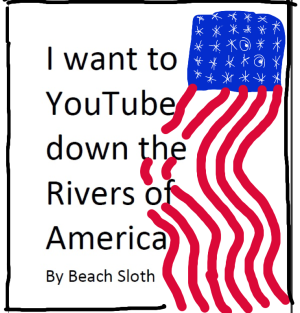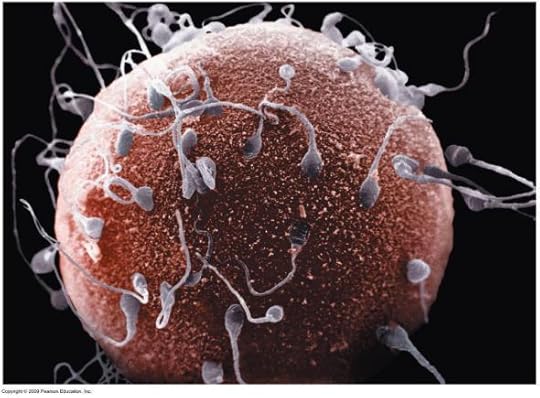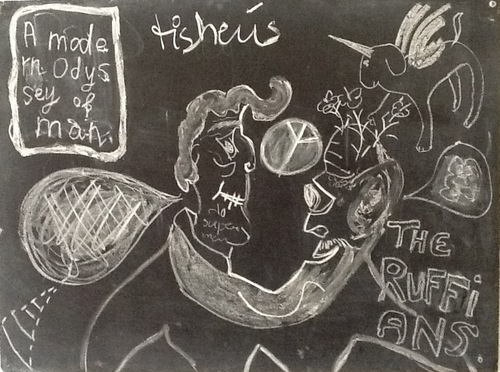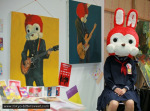Marcus Speh's Blog, page 9
July 24, 2012
Making and marking
Making: I don’t seem to be able to discipline myself to write during these last few weeks. Only routines that I can do mindlessly I can really do mindlessly and then I can forget them again, which is okay; I wish there was more in my life that had this hard to define quality of being mindless, a paradox to discuss using your mind, of course. All I know is that I sit down every morning very early as I’m used to, surrounded by the tools of my trade, but as soon as I hold the hammer, I freeze up: it is almost as if someone is continuously speaking in the background, but I can’t decipher what he says, or when I can decipher it, there’s no paper to put it on, or when I put it on paper, it disappears right away. This is how it is right now. If there’s any fun in the process then it’s of the grim kind. As soon as I stop talking to myself I can hear the blood rush through my ears down the veins of my neck to the heart where the blue blood and the red blood mix. In a way, writing is the brain eating itself. It’s important to bring fresh food to the mind plate.
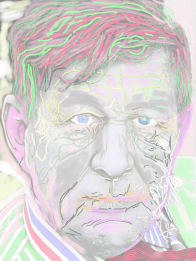
Photo: Auden in Berlin © Mark B. Anstendig, modified by me on iPad. Click for larger image.
Marking: I like to draw, not necessarily in any original way: as in the image shows, I’m perfectly happy to make marks. Getting lost in the mark–making is pure relief from the pressure of word–shaping. It’s mindless all right. And while I am making those marks, even though I use an iPad, words, new words and sentences, are beginning to form like the foundations of buildings in the fog. It brings to mind words spoken by W H Auden into the void when the world was slipping into war. His diction and tone are almost as important as the words themselves. You can trace every mark in his face back to an unhappy thought or to a joyful rhyme.
For about him to the very end were still
those he had studied, the fauna of the night,
and shades that still waited to enter
the bright circle of his recognition
(From: Auden, “In Memory of Sigmund Freud“, 1940).
All writing it seems to me is wrestling with the creatures who live in that “fauna of the night”. Who knows, perhaps I’ll simply retreat to making marks on the surface.
[Open this at One Thousand Shipwrecked Penguins][Original photo]

Making is marking
Making: I don’t seem to be able to discipline myself to write during these last few weeks. Only routines that I can do mindlessly I can really do mindlessly and then I can forget them again, which is okay; I wish there was more in my life that had this hard to define quality of being mindless, a paradox to discuss using your mind, of course. All I know is that I sit down every morning very early as I’m used to, surrounded by the tools of my trade, but as soon as I hold the hammer, I freeze up: it is almost as if someone is continuously speaking in the background, but I can’t decipher what he says, or when I can decipher it, there’s no paper to put it on, or when I put it on paper, it disappears right away. This is how it is right now. If there’s any fun in the process then it’s of the grim kind. As soon as I stop talking to myself I can hear the blood rush through my ears down the veins of my neck to the heart where the blue blood and the red blood mix. In a way, writing is the brain eating itself. It’s important to bring fresh food to the mind plate.

Photo: Auden in Berlin © Mark B. Anstendig, modified by me on iPad. Click for larger image.
Marking: I like to draw, not necessarily in any original way: as in the image shows, I’m perfectly happy to make marks. Getting lost in the mark–making is pure relief from the pressure of word–shaping. It’s mindless all right. And while I am making those marks, even though I use an iPad, words, new words and sentences, are beginning to form like the foundations of buildings in the fog. It brings to mind words spoken by W H Auden into the void when the world was slipping into war. His diction and tone are almost as important as the words themselves. You can trace every mark in his face back to an unhappy thought or to a joyful rhyme.
For about him to the very end were still
those he had studied, the fauna of the night,
and shades that still waited to enter
the bright circle of his recognition
(From: Auden, “In Memory of Sigmund Freud“, 1940).
All writing it seems to me is wrestling with the creatures who live in that “fauna of the night”. Who knows, perhaps I’ll simply retreat to making marks on the surface.
[Open this at One Thousand Shipwrecked Penguins][Original photo]

July 23, 2012
the berlin summer sucks but beach sloth scores while an american grandmother blows up a beautiful buick
Beach Sloth said:
«I really love your work. Will you ever do any readings here in America?»
— i replied: «hi, i love your work, too! i always find it hard when my work is liked by someone whose work i find just so-so. i suppose that is a natural limit to the number of fans i can have. i think i have about 50 real fans now, while i have got no more than 3 really good, close friends. but i have 350+ facebook fans and 6000+ twitter followers. the numbers fry my crocodile brain. when i began, i wanted 100,000 readers from all over the world: my hope was that they would help me support myself—$1 per year from each of them would settle everything. now this thought strikes me as mad, crude and lacking in humbleness. it makes me want to write prose poems on shells, stones and bones again and thrust them into the ocean as artefacts, as unique as a scent or a squeaking chair in the room where i sit writing this, alone. i will turn this letter (is an e-mail even a letter?) into a blog post, knowing that i’m serving the triple-toed god of paradox when i do it, but it’ll also bring you more readers. in you last collection, «I want to YouTube down the Rivers of America», i especially like «American»:
Tastes like the tears of a collapsed 72 Buick | R ight before the old grandmother takes out a shotgun and blows the car to hell | Yum | I got the stomach to be an American.
damn beach sloth, this is so good. best $5 i invested this week. do you think i should self-publish my penguin posts? thanks about asking about me reading in the US: i sure hope i’ll go there, mate. and you should all come to berlin. the weather sucks but the city’s hot like a clever gorgeous woman with yellow hair who hides herself in a thick smelly sweater.»
[Image: modified cover of Beach Sloth's chapbook][Beach Sloth about me][Beach Sloth is Alt Lit][View at 1000 Shipwrecked Penguins]. [Frank Hinton: "Beach Sloth seems a worthy person to pay attention to and follow. He has peaked my interest to higher levels than most blogs. His writing has becoming highly attentive to "internet poetry" with a strong focus on Steve Roggenbuck, Poncho Peligroso and the tribe of HTMLminimalist boykittens meowing about the litsphere."]

July 21, 2012
Winckelmann’s Letters To Berenice
It appears that Winckelmann, when he was already famous and could look back at a distinguished career, fell in love once again. Her name was Berenice and he wrote her letters full of rather unrestrained passion.
Goethe, himself not a sad sack and proud of his own letter-writing, calls Winckelmann a splendid fellow, “who poured his entire natural freedom out on the paper when writing letters and displayed his feelings without concern.” We must presume that he knew of Winckelmann’s letters to Berenice though they are not mentioned as such anywhere in Goethe’s essay.
Upon thorough analysis, the scholar in charge of the investigation, a certain Dr. Alfons Lowenstein, realised that Winckelmann’s Berenice was a Zebra. The famous man of letters had made use of the whole range of “natural freedom” and made love to an equid.

We don’t know much about Lowenstein. We know that he was married. We know that he had previously dabbled in psychiatry in as much as anyone can dabble in the science of disturbed minds, but the mental strain had proven too strong for him. He’d chosen mid-18th century art history as his field of study because it was far enough from the excesses of Nietzschean existentialism, which scared him.
Lowenstein must have been appalled at first. When researching Winckelmann’s correspondence that he thought elevated and dealing with questions of aesthetic verity he was thrown into a maelstrom of feelings resting on a spongy bed of sexual transgression.
Via Lowenstein’s wife we know that his goal was to suppress any knowledge of the perverted nature of Winckelmann’s love life. In one of the letters, there were rather explicit descriptions of sex-making, as Lowenstein called it privately. “The zebra,” Lowenstein noted, “has never truly been domesticated.” This fact may have attracted Winckelmann’s curiosity in a time when the bourgeoisie was beginning to believe themselves to be masters of the universe. We know that Lowenstein became so interested in the species that he wed one himself: Ms Lowenstein was an Imperial Zebra from Kenya called Xanthippe. She was likely much younger than her husband, perhaps by as much as forty years.
We don’t know what happened to Lowenstein and his spouse in the end. He got lost among the stones, etchings and musings of the past, as did Winckelmann’s Berenice. Only Winckelmann’s deeds as an archeologist and his tamer letters to humans are truly known and discussed openly today.
 Note: Johann Joachim Winckelmann (1717-1768) was an important German art historian and archeologist. He sets a beautiful example for the influence and domination of art over society. He championed the doctrine of art as creative imitation (Nachahmung) rather than copy and initiated German idealism. One of the first Germans to publicly be known as gay, he was murdered under murky circumstances in Trieste.
Note: Johann Joachim Winckelmann (1717-1768) was an important German art historian and archeologist. He sets a beautiful example for the influence and domination of art over society. He championed the doctrine of art as creative imitation (Nachahmung) rather than copy and initiated German idealism. One of the first Germans to publicly be known as gay, he was murdered under murky circumstances in Trieste.

July 20, 2012
A Dangerous Method

Carl: young and yearning
Finally, after months of protracted suppression, I watched the latest Cronenberg movie, “A Dangerous Method”. It is based on “A Most Dangerous Method” by John Kerr. Now revisiting my life, with Freud, Jung and others, nameless gravediggers of psychic innocence, looking over my shoulder. It’s so easy for me, and always has been, to lose myself among the sages of Vienna. Their scientific ferocity always attracted me. They led a double life in their day, and their duplicity, especially in moral matters, enabled some of those fireworks that we can still smell now, more than 100 years later.
Twenty years ago, Hillman and Ventura wrote “100 years of psychotherapy–and the world’s getting worse”. But, how could it be otherwise. Since we are only beginning to understand the meaning of “bad”. You see, I wrote this last sentence without meaning to. And now I’m looking at it and cannot make sense of it, though its truth seems undeniable to me. But I’ve always had a severed relationship with badness and evil. Somehow, I could never believe them. Like an alchemist, I optimistically hold on to the transformation of mud into gold, and of bad into good. In the struggle between Jung and Freud, I’m on Sigmund’s side (if only because he was by far the better writer). In his essay «Creative Writing and Day-Dreaming» (1908), he says:

Chubby Sigmund
“Might we not say that every child at play behaves like a creative writer, in that he creates a world of his own, or, rather, re-arranges the things of his world in a new way which pleases him?”
KK: potty and pouty.
In the movie, Fassbender (forever Magneto, good mix of German and Irish gazing at infinity across Zürich lake in the end) and Mortensen (Always On The Road to looking more tortured and more distinguished at the same time, his suffering-gentleman face graced by a cigar) were convincing while Knightley (yes, King Arthur’s spouse turned Russian hysteric) was just as annoyingly pouty as she always is, and yet I can’t help finding her watchable.
Photo: the real Jung, 1910 (above); the child Freud (middle), and Knightley as Sabina Spielrein (below). See also: Sigmund Freud. “Creative Writers and Day-Dreaming”. Standard Edition of the Complete Psychological Works of Sigmund Freud. Trans. James Strachey. Vol 9. London: Hogarth, 1953-74. 24 vols. (Online)

100 Days Of Summer
Between July and September I’ll be blogging at my outhouse, the 1000 Shipwrecked Penguins, as part of a 100 days of summer project. Take it as a holiday on penguin island. There’ll be occasional German blog posts elsewhere, too, and, of course, bollocks.
Head over there, please, but don’t forget this venue. I’ll be back in October, when my debut collection will be published by MadHat Press.

July 16, 2012
the short story of the short story
 «It is well known that the short story was invented by the Man in the Moon for two important reasons worth reminding ourselves of no matter where we live or what we’re made of: the first is that the Man in the Moon always found it difficult to finish a novel because of the instability of the moon’s light conditions. Imagine having to read with a flickering candle light—no fun. The other one has to do with love. The Man in the Moon loves Luna, the Woman in the Moon, the mother of menstruation: he found that reading a novel takes him for too long too far away from her. The multitude of characters, the often complicated plot, the superimposed structure of the classical, readable novel make it hard to simply dive in and climb out of it. The short story, on the other hand, especially in the form of its younger cousin, the flash story, is more often wild and won’t mind reckless, rickety reading. The short story is pure and easy, short and succulent. But perhaps you find this hard to believe even though your own mother and father told you about the Man and the Woman in the Moon, the projection of humanity on the round, scarred, friendly face of Earth’s eternal companion. Perhaps you have a much better, more rational, modern explanation for the existence of the short story. As things stand between us, I like my own version, not in the least because it’s short.»
«It is well known that the short story was invented by the Man in the Moon for two important reasons worth reminding ourselves of no matter where we live or what we’re made of: the first is that the Man in the Moon always found it difficult to finish a novel because of the instability of the moon’s light conditions. Imagine having to read with a flickering candle light—no fun. The other one has to do with love. The Man in the Moon loves Luna, the Woman in the Moon, the mother of menstruation: he found that reading a novel takes him for too long too far away from her. The multitude of characters, the often complicated plot, the superimposed structure of the classical, readable novel make it hard to simply dive in and climb out of it. The short story, on the other hand, especially in the form of its younger cousin, the flash story, is more often wild and won’t mind reckless, rickety reading. The short story is pure and easy, short and succulent. But perhaps you find this hard to believe even though your own mother and father told you about the Man and the Woman in the Moon, the projection of humanity on the round, scarred, friendly face of Earth’s eternal companion. Perhaps you have a much better, more rational, modern explanation for the existence of the short story. As things stand between us, I like my own version, not in the least because it’s short.»
From: Atticus Books Blog, “Marcus Speh: Flash Fiction Encourages Reckless, Rickety Reading (and that’s okay)“, May 9, 2012.

July 12, 2012
Contraption
«When you first enter a madhouse as an inmate, your learn to fear the sounds: dreams rumble and rattle across the corridors. Giant birds kept in tiny cupboards shriek senselessly. Even the silence is loud when your mind has faltered and turned against itself. But soon, these sounds become your new world. So much so that you fear to ever leave it: when you are picked up by your family for the weekend, anything will unnerve you—the bark of a dog, a whimpering of a child, the pure ringing of a bell. Even the rustle of a skirt over the leg of a woman will stir you and make you crazy. You’ll feel forced to interpret these sounds which seem regular to your kin and to prove to them that they in fact are the mad ones. All crazies are like that, except perhaps those who were born stone deaf. Their fantasies hold no sound: to them, people who speak just move their lips like animals licking the air with tied tongues. Anything that falls to the floor in their world falls like a feather, toneless, as if they lived on a planet without atmosphere, a muted asteroid. Only the deaf idiots can stand the clattering of coffee dishes and cake spoons on the family afternoon table. They smile upon the loony sizzling of the Sunday roast in the oven. When they’re overwhelmed they simply close their eyes.»
From: An Aotearoa Affair, Carnival 4: “Flash Across Borders”; Deutsche Version: “Im Irrenhaus“. Image: Goya, Loco tras las rejas (1824).








July 11, 2012
The Ruffians
“The Ruffians, old superman and tisheús — A Modern Odyssey of Man.” Kick-off for the 2012 father-daughter summer kitchen sink drawing project. (Of course you know nothing about me, and why would you, and why should you. In our kitchen we have a very large blackboard, the old type, which doesn’t interact with you just because you put your grubby fingers all over it. This is where the family jointly composes shopping lists like vegetable operas. Every once in a while, an anarchic spirit moves into me. This is the emergence of The Ruffians, and my daughter happily joined me on this particular Cretaceous journey. As a character, Odysseus more often than not appears during these exploits, with unicorned flying dogs watching over him. Just like real life. “tisheús” is a mixture, the concoction of “tissues” and “Theseus”: all children should be free to mix mythological material with modern day implements.)
[#4 of 100 Days Of Summer.]








July 10, 2012
the red bunny plague
Dear constant reader, as Stephen King is fond of saying, you already know that I get all too easily addicted to new projects. That I engaged readily, back paddle frantically, surge, retreat, ask for support and then deny that I need any… In other words: it’s complicated with me and projects. One of the projects that I’ve been looking forward to begin, however, is the 100 days of Summer writing. Begun elsewhere, these summer’s posts are now coming home. New posts will first appear at One Thousand Ship Wrecked Penguins after which I will move them here. And now let’s move on to red bunnies…
I’m thinking about things that might happen and that might turn your world-view upside down (we say “Weltanschauung” which implies a totality of view perhaps no known, or perhaps not attempted in English): what if, all of a sudden, every buggy carries a red bunny head, and the babies cruising in them also carry the red bunny sign as do their parents. It’s either tattooed on or they have it from birth. Everybody is happy. The bunny face suggests this happiness. In this world, everyone makes love like rabbits do, maybe that’s the secret of happiness. A friend from Russia is walking the streets with me. Neither of us has the red bunny. We feel like strangers in the midst of all the bunny-induced merriment. It’s not that we reject the bunny, but rather the bunny has rejected us. At home, my wife greets me silently and solemnly. She takes my hand with great tenderness and takes me to our daughter’s room: there she lies, snoring like a child snores, evenly, unagitated, a bunny head on her shoulders, the red flabby ears spread out on the white pillow. My wife gives me a furry smile. My mouth is dry, but I’m insanely happy, I really am.
[#3 of 100 Days Of Summer.]









